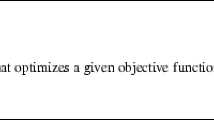Abstract
Network location problems occur when new facilities must be located on a network, and the network distances between new and existing facilities are important. In urban, regional, or geographic contexts, there may be hundreds of thousands (or more) of existing facilities, in which case it is common to aggregate existing facilities, e.g. represent all the existing facility locations in a zip code area by a centroid. This aggregation makes the size of the problem more manageable for data collection and data processing purposes, as well as for purposes of analysis; at the same time, it introduces errors, and results in an approximating location problem being solved. There seems to be relatively little theory for doing aggregation, or evaluating the results of aggregation; most approaches are based on experimentation or computational studies. We propose a theory that has the potential to improve the means available for doing aggregation.
Similar content being viewed by others
References
L. Bach, The problem of aggregation and distance for analyses of accessibility and access opportunity in location-allocation models, Environ. Planning A13(1981)955–978.
M.L. Brandeau and S.S. Chiu, An overview of representative problems in location research, Manag. Sci. 35(1989)645–673.
P.J.B. Brown and I. Masser, An empirical investigation of the use of Broadbent's rule in spatial system design, in:Spatial Representation and Spatial Interaction, ed. I. Masser and P.J.B. Brown (Martinus Nijhoff, Boston, MA, 1978).
P.A. Casillas, Data aggregation and thep-median problem in continuous space, in:Spatial Analysis and Location-Allocation Models, ed. A. Ghosh and G. Rushton (Van Nostrand Reinhold, New York, 1987), pp. 327–344.
J.R. Current and D.A. Schilling, Elimination of source A and B errors inp-median location problems, Geograph. Anal. 19(1987)95–110.
J.R. Current and D.A. Schilling, Analysis of errors due to demand data aggregation in the set covering and maximal covering location problems, Geograph. Anal. 22(1990)116–126.
M.S. Daskin, A.E. Haghani, M. Khanal and C. Malandraki, Aggregation effects in maximum covering models, Ann. Oper. Res. 18(1989)115–140.
P.M. Dearing, Location problems, Oper. Res. Lett. 4(1985)95–98.
M.L. Fisher, Worst-case analysis of heuristic algorithms, Manag. Sci. 26(1980)1–17.
R.L. Francis and J.A. White,Facility Layout and Location: An Analytical Approach (Prentice-Hall, Englewood Cliffs, NJ, 1974).
R.L. Francis, T.J. Lowe and H.D. Ratcliff, Distance constraints for tree network multifacility location problems, Oper. Res. 26(1978)570–596.
R.L. Francis, L.F. McGinnis and J.A. White, Locational analysis, Eur. J. Oper. Res. 12(1983)220–252.
R.L. Francis, L.F. McGinnis and J.A. White,Facility Layout and Location: An Analytical Approach, 2nd ed. (Prentice-Hall, Englewood Cliffs, NJ, 1992).
M.F. Goodchild, The aggregation problem in location-allocation, Geograph. Anal. 11(1979)240–254.
S.L. Hakimi, Optimal locations of switching centers and the absolute centers and medians of a graph, Oper. Res. 12(1964)450–459.
S.L. Hakimi, Optimal distribution of switching centers in a communication network and some related graph theoretic problems, Oper. Res. 13(1965)462–475.
J. Halpern and O. Maimon, Algorithms for them-center problem: a survey, Eur. J. Oper. Res. 10(1982)90–99.
R.W. Hamming,Numerical Methods for Scientists and Engineers (McGraw Hill, New York, 1962).
E.L. Hillsman and R. Rhoda, Errors in measuring distances from populations to service centres, Ann. Regional Sci. 12(1978)74–88.
W.L. Hsu and G.L. Nemhauser, Easy and hard bottleneck location problems, Discr. Appl. Math. 1(1979)209–215.
O. Kariv and S.L. Hakimi, An algorithmic approach to network location problems, I: Thep-centers, SIAM J. Appl. Math. 37(1979)513–537.
O. Kariv and S.L. Hakimi, An algorithmic approach to network location problems, II: Thep-medians, SIAM J. Appl. Math. 37(1979)539–560.
J. Krarup and P. Pruzan, Selected families of location problems, Ann. Discr. Math. 5(1979)327–387.
E.L. Lawler,Combinatorial Optimization: Networks and Matroids (Holt, Rinehart and Winston, New York, 1976).
T.J. Lowe and L.B. Schwarz, Parameter estimation for the EOQ lot-size model: Minimax and expected value choices, Naval Res. Logist. Quart. 30(1983)367–376.
P.B. Mirchandani and A. Oudjit, Localizing 2-medians on probabilistic and determinisitic tree networks, Networks 10(1980)329–350.
P.B. Mirchandani and J.M. Reilly, Spatial nodes in discrete location problems, Ann. Oper. Res. 6(1986)203–222.
P.B. Mirchandani and R.L. Francis (eds.),Discrete Location Theory (Wiley, New York, 1990).
J.M. Mulvey and H.P. Crowder, Cluster analysis: an application of Lagrangian relaxation, Manag. Sci. 25(1979)329–340.
C.H. Papadimitriou and K. Steiglitz,Combinatorial Optimization: Algorithms and Complexity (Prentice-Hall, Englewood Cliffs, NJ, 1982).
D.F. Rogers, R.D. Plante, R.T. Wong and J.R. Evans, Aggregation and disaggregation techniques and methodology in optimization, Oper. Res. 39(1991)553–582.
G. Rushton, Applications of location models, Ann. Oper. Res. 18(1989)25–42.
B.C. Tansel, R.L. Francis and T.J. Lowe, Location on networks, a survey, Parts I and 2, Manag. Sci. 29(1983)482–511.
B.C. Tansel, R.L. Francis, T.J. Lowe and M.-L. Chen. Duality and distance constraints for the nonlinearp-center and covering problem on a tree network, Oper. Res. 30(1982)725–744.
G. Handler and P.B. Mirchandani,Location on Networks: Theory and Algorithms (The MIT Press, Massachusetts, 1979).
Author information
Authors and Affiliations
Additional information
This research was supported in part by the National Science Foundation, Grant No. DDM-9023392.
Rights and permissions
About this article
Cite this article
Francis, R.L., Lowe, T.J. On worst-case aggregation analysis for network location problems. Ann Oper Res 40, 229–246 (1992). https://doi.org/10.1007/BF02060479
Issue Date:
DOI: https://doi.org/10.1007/BF02060479




